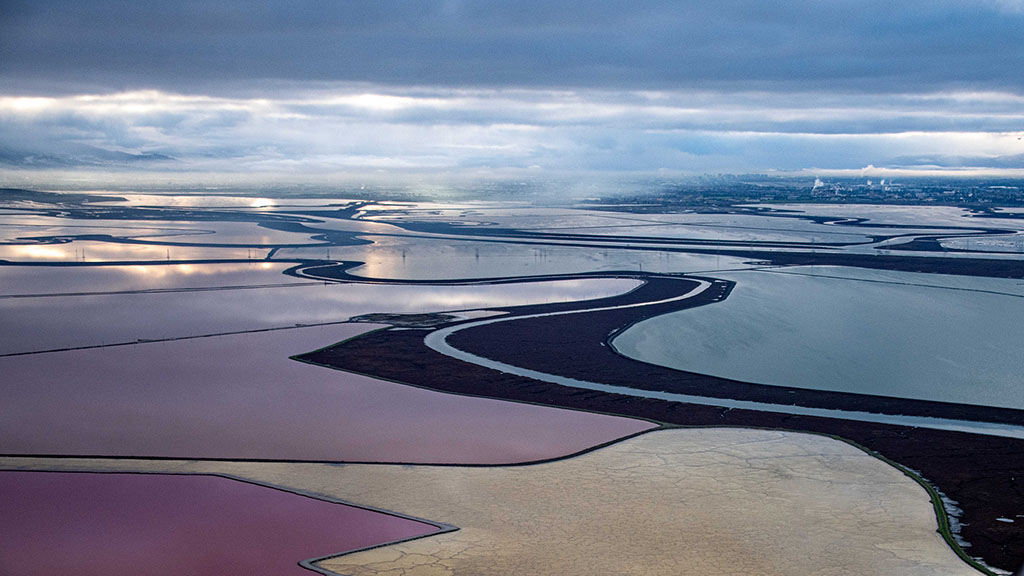In celebration of our 35th year of defending San Francisco Bay, each month we’re sharing significant victories that we’ve won together. And we’re highlighting how these wins are still making waves today!
Curious about the colorful ponds in the South Bay that you see when flying from SFO? Once upon a time, the Cargill corporation created those ponds by flooding shoreline wetlands with Bay water to use the area in their salt making process.
In recent years, Cargill retired some of those ponds and tried to sell the “land” to developers to build luxury housing and commercial retail development. But the company kept running into permitting obstacles under the Clean Water Act.
Eventually, they found a willing friend in the Trump administration. Trump’s EPA decided to help Cargill by making the bizarre claim that the salt ponds weren’t water. That would have allowed Cargill to side-step the Clean Water Act, and it would have set a dangerous precedent for wetlands around the Bay.
So Baykeeper led a coalition of partners to challenge that claim in court. And, the judge agreed with us. Our legal victory held that ponds are, in fact, water (of course!). And because they’re connected to the Bay, they’re protected by the Clean Water Act from fill and pollution.
Now we’re advocating for this 1,400-acres to be restored to its original marshland state. Rewilding the area will help buffer shoreline neighborhoods from sea level rise and maintain welcome habitat for birds and other wildlife.
Unwise development proposals like this have historically destroyed 90% of the Bay’s wetlands. That’s why, over our 35 years, Baykeeper has vigilantly kept an eye out for shortsighted development proposals that could harm the Bay, its wildlife, and local communities. Here are some other notable wins:
- 2018 Clipper Cove: This spot at Treasure Island is home to native eelgrass beds, which provide shelter for fish and shellfish, and food for migratory birds—and are one of the most-threatened habitats in California. That’s why Baykeeper and our allies objected when developers unveiled plans to convert the cove into a marina large enough to fit 80-foot mega-yachts. The SF Board of Supervisors listened and greatly reduced the original development plan. Now, a majority of the cove will stay open to preserve the eelgrass, and the spot will remain home to a sailing school for Bay Area youth.
- 2022 Point Molate: This beach in Richmond has long been considered a crown jewel of San Francisco Bay. In 2013, Baykeeper led the cleanup effort to remove 96 tons of trash and debris to remove pollution and make the area more publicly accessible. But because of its spectacular Bay views, it has also been eyed for the past 15 years as a prime spot for building a casino and luxury homes. So, Baykeeper joined forces with local community members to oppose these misguided plans, and now Point Molate is set to become a regional shoreline park that everyone can enjoy.
- 2023 Brooklyn Basin: In Oakland, a proposed development project was set to include a large private marina that blocked public access to the waterfront and harmed vital marshland habitat (a habitat that Baykeeper helped create two decades ago!). We joined community allies to ask the developers to reconsider—and they listened. The big marina plan is gone, and the project now includes public access to the Bay, including a kayak and paddleboard launch, and new housing that’s classified as affordable. The revised project shows how shoreline development and Bay protection can go hand in hand.
Ongoing wins at De-Pave Park: Sea level rise poses a major threat to Alameda, a low-lying island in San Francisco Bay. Shoreline neighborhoods there will face a high risk of flooding, and rising tides could wash pollution into the Bay from contaminated sites. That’s why for the last few years, Baykeeper and our allies have advocated to turn a paved area of the old decommissioned naval base at Alameda Point into a nature preserve. The city council has taken multiple positive steps to move the plan forward to remove pollution, buildings, and asphalt to return the area to its natural state. Restoration is set to begin as soon as full funding is secured, with a brand-new park slated to open in 2028.
Baykeeper will keep advocating to stop unwise development and rewild the Bay’s shoreline so that the Bay Area can be resilient to sea level rise for generations to come.
Baykeeper’s work has made waves across the Bay—and your support over the years has made it all possible. You can learn about our victories in the timeline below.
Photo at top by Robb Most, with thanks to LightHawk Conservation Flying

